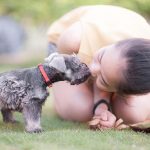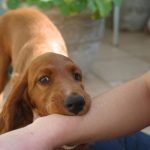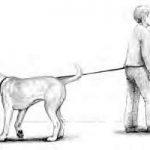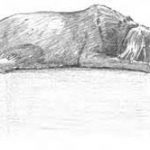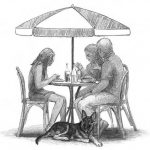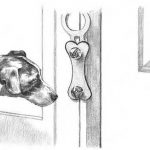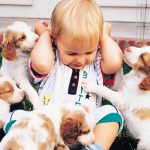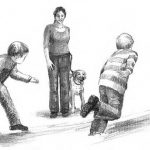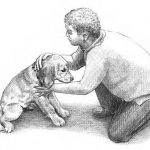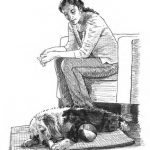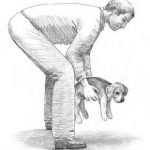Living with Your Puppy in the Real World
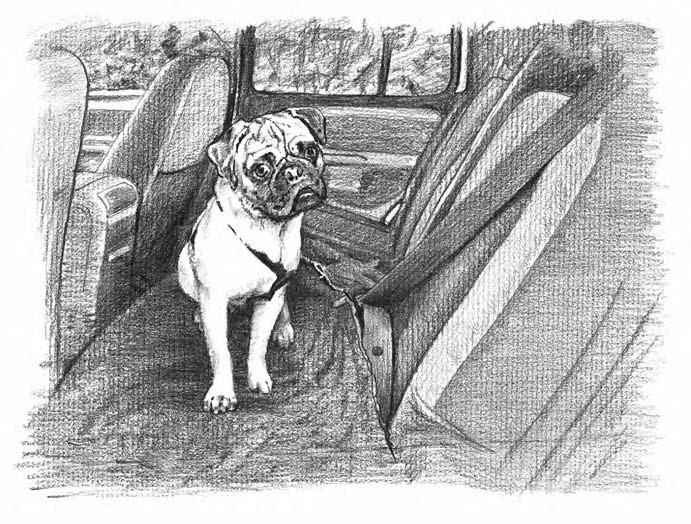
In This Chapter
- Being a good neighbor
- Helping your puppy adjust to life changes
- Traveling by plane, boat, or automobile
Yes, life beyond your four walls holds endless possibilities, and you should take your dog with you wherever life leads. The key is in knowing how to direct your puppy so that she’s a welcome presence everywhere you go. Knowing how to manage every nuance that life can throw at you — from greeting other people and pets to curbing the chasing instinct as well as welcoming new people or animals into your home — is what this chapter is all about.
Life in the ’Hood
Five signs that you’re a bad dog neighbor
|
Respecting your neighbors
Remember
The question is: Which of these two types of neighbors do you want you and your puppy to be classified as? The choice is yours, but if you want to be well-respected, it’s not difficult — just follow these steps (turn to Chapter Training through Your Pup’s Growth Stages for details on these directions):
– Instruct “Heel” as you parade around the neighborhood and teach your puppy to follow your lead.
– Use the “Wait” direction to teach your puppy to wait at curbs and to wait while you visit or window shop.
– Teach the “No” direction to discourage your puppy from going after everyday temptations, such as cars, joggers, and other animals. (You can introduce the concept of “No” when your pup’s 16 weeks old.)
Tip
If your dog’s lunging at the end of the leash and trying to get at whatever has her attention, you’re too late to discourage her. Impulse rules, but if you can anticipate her reaction by watching your surroundings for temptations and correct her just before she reacts, you’ll be able to refocus her before her instincts take over.
– Make sure your puppy potties on your own property. As they grow into adulthood, puppies recognize boundary limits with their noses. Help your pup learn where her territory ends by keeping her close while walking around the parameters of your yard or block. In case of an accident, carry a bag with you so you can remove the evidence from your neighbor’s lawn. Don’t forget to also dispose of the evidence properly.
Dealing with other neighborhood dogs
Remember
The leash should be used to communicate leadership — human leadership, that is. Puppies, however, don’t always listen to that message. Some puppies think they’re supposed to walk their owners. A confident puppy leading its owner wants to approach other dogs, and when she’s suddenly restricted by a choking feeling around the neck or chest, she gets very defensive. She pulls harder and gets more intense. As she grows up, she threatens from afar when she sees other dogs. A better approach is using the direction “Heel,” which teaches your puppy to look to you for direction and in turn helps her to feel safe and guarded (see Chapter Training through Your Pup’s Growth Stages).
Remember
Resist the temptation to soothe a frightened puppy. Your intentions are pure, but because a puppy views the soothing as submissive and fearful, you’re only reinforcing your pup’s concern. Act brave and calm, and speak in directional tones. Kneel down and brace your puppy as described in Chapter Life from His Paws: Understanding Your Puppy’s View of the World, and use familiar directions to help contain her fears.
– Don’t look at the other dog.
– Walk by the dog at a brisk pace.
– Keep your dog behind you at all times.
Warning!
If you and your on-lead puppy are approached by an angry, off-leash dog, walk swiftly from the scene, correcting your pup so that she doesn’t face off to the aggressor. If either of you makes eye contact with the dog, you may be attacked. If your puppy is small enough, pick her up calmly and swiftly leave the area. Cup your hand gently over your puppy’s muzzle to discourage squirming.
Leaving your pup home alone
Tip
Preparing for your departure has lasting benefits. Before you leave, do the following:
– Exercise your puppy for ten minutes.
– Follow playtime with a two-minute training session.
– Leave a couple of chew toys and scent them by rubbing them in your palms.
– If you leave your puppy indoors, leave her in a dimly lit, confined space with an old shirt or blanket and a radio playing soothing tunes.
– If you leave your puppy outdoors, provide her with access to a shaded area and plenty of fresh water.
Warning!
If your puppy suffers from separation anxiety and is a gulper (which means that she eats things she shouldn’t), crate or enclose her in a small space with a large bone and no bedding. You don’t want to leave bedding for your pup because she may eat it when she becomes upset that you’ve left.
Picking up your puppy’s messes
Just For Fun
A couple of guys in my area opened a business called Poop Patrol. These guys are forever dedicated to keeping yards free of puppy messes. There’s a business idea for all you entrepreneurs!
Dealing with the chasing instinct
Remember
Chasing is an instinctive behavior that goes back to the canine ancestor — the wolf — who had to hunt for a living. Even though owners offer their puppies all the luxuries of retirement (read: a free buffet of kibbles two times a day), many still think chasing (anything, but especially cats) is a great pastime.
Chasing the neighborhood cats
Tip
If your puppy has already formed the chasing habit, don’t fret. You can still resolve things. Follow these steps:
1. Secure a light 6-foot nylon leash to your puppy’s collar.
2. Focus on your dog’s ears as you walk (ear perk is a sign that a chase is in your pup’s future).
To influence the chasing problem, you must correct the thought process, not wait until the chase has begun. Dogs’ ears act like built-in radar systems. They can pick up sounds in every direction. Unfortunately, if your puppy’s ears are alert to every other distraction, she’s not focused on you. So, in this case, training is definitely in order.
3. If your dog’s ears lift when the cat saunters by, tug the leash quickly and say “No!”
Don’t look at the cat or the puppy at any time during the interaction. Eye contact means interest.
4. Walk away from the cat confidently. Encourage your puppy to come along with the direction “Let’s go!”
5. Continue to quickly tug and release the leash and say “No” until your puppy focuses on you.
Don’t drag your pup away from the object. Instead, tug and release, and wait for your puppy to follow you willingly.
Chasing the neighborhood cars
1. Instruct your dog with the command “To the side” and run to the curb quickly.
2. Tell her “Wait” as the car passes, bringing her behind your heels.
3. If she looks at the car, say “No!” very sternly and tug the lead quickly.
Tip
Use this same technique with bikers and joggers. Correct your dog the second she thinks about chasing something. After she’s in motion, you’re too late.
Adapting to Life Changes
Moving in to a new home
Tip
Following are some suggestions that you can use to help her:
– Play some classical music while you debate and discuss your big move. It’ll calm everyone.
– Include your dog in your packing activities. Don’t isolate her in the backyard. If she gets in the way, station her with a bone to chew, and pet her when she settles down.
– If you’re traveling back and forth to the new house, lead your puppy in the home using familiar commands, such as “Wait” and “Let’s go.”
– Create stations in your new home using familiar toys, leashes, and bedding.
– If you’re spending the day at your new house, don’t forget to pack some dog food and water. Bring her familiar bowls.
– Keep your dog with you while you’re unpacking. Let her sniff the collectibles as you remove them; she identifies objects with her nose and will feel happy to recognize something.
Remember
The first time you leave your puppy in your new home, she may stress out, resulting in destructive chewing or excessive barking. Confine your puppy in a small room or crate with one of your old shirts and a favorite chew toy. Don’t correct your puppy if she demolishes something. Your corrections only increase the anxiety and destruction. Puppy-proof the area ahead of time. If you come back to destruction, ignore it and clean the area up later when your puppy is occupied.
Warning!
Don’t let your puppy off-leash in your new yard unless it’s fenced in or she’s secure on a long line. She’ll be disoriented for a few weeks and may get lost if she wanders off. Was your old place fenced in? If your dog was accustomed to running free in a yard but can’t anymore, you need to make up for the loss. Use a long line or a retractable leash and discover some good games to burn off that energy. Flip to Chapter Home Sweet Home for more info on leads and long lines and to Chapter Ten Fun Games to discover some fun puppy games.
Mourning the loss of a loved one
– I asked a friend to walk them in the morning and had the neighbor’s kid come by in the afternoon.
– I set my alarm clock to ring at their mealtimes.
– I set aside five minutes per day for an obedience lesson.
– I bought them new chews and tried to play kick the bottle (their favorite game) with them in the afternoon.
Remember
Losing a loved one isn’t an easy place to be in. Your world is forever changed, and yet daily demands continue — especially from those who depend on you. Get through one day at a time, ask for help when you need it, and find life in the love you share.
And baby makes three: Expanding your family
Preparing your pup for the new arrival
Remember
A new baby in the house can be one of the coolest changes of a lifetime — for people, that is. Puppies, on the other hand, often feel shafted and like they’ve been moved to the back burner. To ensure that your four-legged pal doesn’t feel left out, start planning for the new arrival.
– As early as possible, socialize your puppy with small children. Put some cereal (cereal has fewer calories than dog biscuits, so it’s okay if kids are very generous) in a cup, and shake and treat until your pup associates the sound with a reward. Then invite over some friends who have children and ask them to shake and treat. Stay calm while they visit, but keep your dog on a leash if you’re uneasy. Dogs are very telepathic, so your emotions come across loud and clear.
– Take your puppy to a playground. Keep her on a 6-foot lead, and if a parent and a child approach together, ask the child to take a break and give your dog a treat.
Warning!
If your puppy shows any signs of aggression, call a professional. Your reaction can make the problem worse. Petting or soothing reinforces the behavior, and disciplining makes your puppy feel more threatened.
– Establish an exercise schedule that will be realistic with your new responsibilities. Mornings may be rough, so help your puppy look forward to afternoon romps instead.
– Establish a station in or just outside your baby’s room, and get your pup accustomed to settling on command. Tell her “Settle down” and secure her on a 3-foot lead if she seems restless.
– Walk through your daily routine with a stuffed doll. Allow your puppy to sniff it regularly. When changing your baby (both the doll and the real thing), practice the directions “Wait” and “Stay” (see Chapter Training through Your Pup’s Growth Stages). When putting your baby down for a nap, guide your puppy to her station while saying “Settle down.” When nursing your baby, give your puppy a special chew and place her mat or bed near your feet.
– Watch your words. Phrases like “What a good girl” must be changed to “What a great dog!” If the phrases you use for baby and dog are too similar, your pup will get confused.
– Set new furniture rules. Dogs shouldn’t be allowed on the furniture near a new infant. If you wait to spring this rule on your pup after the baby’s home, the puppy may feel shafted, so lay down the law now. Keep a short leash on your puppy’s buckle collar, and if she hops up, quickly tug the lead handle and say “No.” Remember, pushing is interactive and suggestive of a game.
Tip
If you must have your dog on the furniture, give her the luxury on command only. Tell her “Up” and pat the cushion when you want her there. Use “No” with a leash correction if she comes up uninvited.
– Get your puppy used to one hour of the cold shoulder every day. Yes, I want you to ignore your puppy completely. You can break it up into two 30-minute or three 20-minute segments, but get your puppy accustomed to life without your doting. If your puppy can get your attention wherever and whenever she wants it, she’ll be upset when you’re focused on the baby.
Remember
– Stop all confrontational games, such as tug of war and wrestling, and eliminate all in-home chasing matches. Play games outside, and teach your puppy calm household manners.
– Consider your child’s toys and how they may compare to your puppy’s favorites. Give your puppy a couple of objects to chew on or play with, return them to your puppy’s bedding when displaced, and use a calm approach to discourage her from going after the child’s toys on the floor. Avoid theatrical reactions when your puppy chooses the wrong object; simply approach calmly, remove the item, and encourage her to find her toy. If your puppy can’t resist snatching forbidden items, place her in her special space (room, pen, or crate) with her toys and wait until she’s calmed down (or you’ve cleaned up) to bring her out again. See Chapter Dealing with Daily Hassles for a more detailed description on how to discourage chewing.
– Grab and tug on your puppy as you treat and praise her. Babies and small children like to grab and pull, and your dog may be startled if the baby’s tug is the first one she experiences. So tug on her coat, pull her tail, and hug her tight. What a wonderful puppy. Isn’t this great? Don’t forget to make some baby sounds, too, for the full effect.
– Don’t give your dog shoes, socks, rags, or plastic or stuffed toys. If you do, she’ll think anything in that category is fair game. Oops, already started that habit? Well, you should stop cold turkey. Stay calm when your puppy gets confused, remove the object without fanfare, and use it to teach your puppy the concept of “No” as described in Chapter Training through Your Pup’s Growth Stages.
When it’s time for baby to come home
– Ask the nurse if you can bring home some bed sheets or blankets from the nursery. It may seem like a strange request, but I’m sure yours won’t be the first. Ask a friend or family member to place these items in your puppy’s play station or crate and around the area where you plan to nurse. Praise your puppy for sniffing them, but discourage chewing or tearing. (Keep your puppy on leash, if necessary.)
– Brush up on obedience lessons while Mom’s in the hospital. Puppies love structure.
Remember
– Hire a dog walker if the house is empty. Isolation is stressful for puppies.
– Introduce puppy and baby on neutral ground. If possible introduce the two as you’re leaving the hospital or outside your home. Exercise your pup before the meeting and bring along some peanut butter to distract your dog’s interest if you’re nervous. Don’t choke up on the lead or shout at your puppy — it’s unsettling and makes a bad first impression.
– Plan your homecoming. Keep your puppy on leash and let her welcome the baby, too. Use the same techniques as the first meeting to ensure a smooth arrival.
– If your puppy’s too boisterous, give her leash a quick tug and say “No ma’am.” Spread some peanut butter on your hand and say “Kisses.”
Tip
The butter trick also works as you establish a bond between your baby and your puppy. Dab some butter on your baby’s hand and say “Kisses” (see Figure 9-1).
– Let your puppy drag a leash and use it to correct all mouthing or jumping behavior. Look at and praise your dog when she’s calm.
– If your puppy is restless at her designated stations, secure the 3-foot lead and hook her up while you direct her to “Settle down.”
Warning!
New infant resentment syndrome (NIRS) is exactly what it sounds like. If your four-legged friend is suddenly excluded from normal daily activities, she’ll feel resentful and may take out her alienated feelings on the new arrival. If your dog growls at the baby, call in a professional to assess the situation.
Bringing home another dog or pup
Remember
Getting another puppy may seem really exciting to you, but your resident pup may be less than thrilled. Some puppies take to new paws on the carpet, but others don’t. To make the transition as smooth as possible, follow the advice in this section.
First introductions
– Stay cool. With or without a leash (the tightening of which conveys tension), if you shout directions at or scold either dog when they’re first greeting each other, both dogs will be nervous wrecks, and nervous dogs are likely to attack.
– Even a young puppy may do a lot of body and vocal bluffing at the initial meeting. When two dogs meet, there may be a lot of posturing and growling. Don’t be alarmed — it’s very natural and necessary. It’s the equivalent of “Hi, how are you? What do you do for a living?” Her hair may stand up, and she may even growl. Meeting anyone for the first time can be a little scary. If you interfere, though, the dogs may fight. Just stand back and ignore them. Interact with them when the initial tension has subsided.
Warning!
Some dogs just don’t get along. If you bring together two dogs of the same sex or two dogs who have both become used to being “only children,” they may fight. Be prepared: Have two people handy to take the leads and run in opposite directions.
Hints for happy two-puppy households
Remember
When left alone 24 hours a day, your puppies will form a strong bond to each other, which is good. However, that means they’ll also be less attached to you, which makes it difficult for you to influence their behavior. To prevent this bonding, separate them at least twice a day and if possible, let them sleep in separate bedrooms. Use individual crates for housebreaking, chewing, or sleeping difficulties.
– A puppy is a puppy is a puppy. Truer words were never written. Certain similarities string all puppies together. However, like humans, each one has her own unique personality and temperament that affects the way she relates to her world. In a multidog household, everyone must be sensitive to the needs of each individual puppy.
– Let your dogs establish their hierarchy. Personality affects the way puppies relate to one another. Groups of two or more puppies form a hierarchy, with the most outgoing, assertive one assuming the leadership role.
Remember
Puppies don’t base hierarchy on who’s the biggest, or who came first. Nor do they base it wholly on who’s the toughest. Hierarchy is based on who’s the most responsible. The puppy with both the brains and the brawn wins out. Regardless of your feelings, you must support their arrangement.
Tip
– Give the royalties to the leader. You must support the hierarchy your puppies set by giving all the household royalties to your leader. She should be fed, greeted, pet, and allowed out first. If you pay more attention to the subordinate dog, you may cause discontent among the ranks, which can lead to fighting.
Although young puppies are submissive, they may challenge the leadership status as they mature, and although it may go against every loving impulse in your body, you need to reorganize royalties based on their decision of who’s the leader.
– Remember the discipline rules. If you don’t know who did it, you can’t correct either puppy. That’s the rule. If you find a mess after the fact, forget it. Correcting both pups only weakens your connection to them and strengthens their resolve to one another. For suggestions on specific problems, see Chapters Dealing with Daily Hassles, When Anxiety Strikes, and Food and Fitnes.
– Wrestling is okay, to a degree. Teach your puppies to go to certain areas of the house or outside to play. If they tend to get out of hand, leave short leashes on them in the house to enable interruption and redirection. Say “Shhh!” as you separate them and then instruct them to go “Outside” or to another area to play. If you don’t have enough space for this technique, instruct “Sit,” and refocus them on chew toys. Crate or secure them at a station if they don’t calm down.
– Play the name game. Teach your puppies two names: their personal names and a universal one that you can use when they’re together, such as “Dogs,” “Girls,” “Boys,” or “Babies” — whatever works for you. Using a single name makes calling them easier; “Girls, come!” rolls off the tongue easier than “Buddy, Fi-Fi, Daisy, Marlo, come!”
– Feed your pups separately. Place your leader’s bowl down first. If you’re having difficulty keeping the puppies separate, create two separate feeding stations (see Chapter Home Sweet Home).
– Don’t start a toy war. I know, you want them both to have a toy. But one puppy keeps insisting on having both. You give it back to the other puppy, and she takes it away. The giving and taking could go on all day. Remember your leadership rule: If the leader wants both, the leader gets both. Period.
Remember
– Whatever you do, don’t yell during a dog fight. Yelling is perceived as threat barking and actually makes the problem worse as your puppy matures. If you have a dog fight, the best thing to do is walk out of the house and slam the door. No words or discipline — just leave abruptly. It’s usually your presence that prompts an argument. You can also try breaking up the fight by dumping a bucket of water on their heads or turning a hose on them momentarily if they’re outside. Also, an excellent product called Direct Stop is useful in fight situations; it’s a fierce spray of citronella that’s not harmful but is startling enough to break up the dogs. You can find it in stores or online.
Tip
After things are calm, review your actions. Were you supporting the underdog? That’s not good. After the fight fizzles out, isolate the subordinate and praise the leader. I know it sounds cruel, but if the leader feels supported, she won’t challenge the other dog. Additionally, if you catch a fight before it begins, shame the underdog and reward your leader with attention. I know it feels unnatural, but remember that your dogs aren’t human, and they don’t think you are either. If the situation repeats itself, call in a professional.
Trips, Tips, and Travel
Packing an overnight bag
– A familiar mat or other bedding
– Regular food that’s separated for each feeding, plus an extra meal or two just in case
– A selection of familiar bones and toys
– Food dishes
– Water, if you’re visiting an environment where bottled water is recommended for human consumption
– Housetraining bell, if your puppy uses one
Taking your puppy on a plane
Taking some preflight measures
Remember
– Plan direct flights late in the evening or early morning to minimize the amount of time your puppy spends in holding. The cargo areas where pets are held before and after their flights are neither heated nor cooled. Please respect the airline rules regarding flying your dog in extreme heat: Suffocation is the biggest risk in airline travel.
– Make your puppy’s reservation when you make your own. Planes only accept so many four-legged passengers.
– Book a direct flight in a large plane. Large planes have better air circulation than smaller ones.
Tip
If you can’t fly direct, book a flight with a layover that’s long enough for you to reunite with your puppy. Take her out for a stretch, drink, potty break, and hug.
– If you’re planning to take your puppy with you overseas, check with the embassy of the country that you’re visiting to find out about regulations and required paperwork. In addition, check with the agriculture department in your state for the heads up on regulations regarding your dog’s return home.
Remember
– Airlines require health certificates and proof of vaccination, so you need to get them from your veterinarian and forward a copy to the airline immediately. Carry one with you the day of the flight, too, in case any questions arise about your dog’s clearance to travel.
Getting your puppy set to go
– Purchase a sturdy USDA-approved travel kennel custom fit to your puppy’s size. Make sure the kennel is only large enough for your puppy to stand up and turn around in.
– Get your puppy comfortable with her kennel quarters a few days before departure.
– If you have a teenie-weenie puppy or dog who can come on board, buy a crate that fits under the seat.
– Write “LIVE ANIMAL” in 1-inch letters on top of the crate and on each side. Tape on huge arrows to indicate the crate’s upright position.
Wanting to go by train? Sorry!I’ve looked high and low and can’t find a rail service that’s dog friendly. Of course, they all allow service dogs on board, and my local metro train allows small, well-mannered dogs on off-peak hours. But traveling by rail with a pup is definitely pretty limiting. |
– On the top of the crate, in 1⁄2-inch letters, write the flight’s destination, including your name and the name, address, and phone number of the person or place you’re visiting.
– Remove all training collars. Your pup should wear a well-fitting buckle collar with identification tags.
– Don’t feed your puppy within six hours of the trip.
– Prep the crate for takeoff with light bedding and paper (taped down) in one end to absorb mistakes. Affix two manufactured kennel bowls inside the crate. Freeze water in one so your puppy can have a drink while in flight.
Warning!
If your puppy is a champion chewer, you may need to nix the bedding. Some puppies are so stressed by air travel that they’d chew the shirt off your back if you were sitting next to them. If you suspect that your puppy will be distressed, ask your veterinarian for a sedative.
– If the flight is longer than 12 hours, tape a bag of food to the outside of the crate with feeding instructions. Don’t be too disappointed if no one’s available to feed your puppy; all you can do is hope.
– Allow your puppy to potty right before you put her in her kennel. Most puppies can’t hold their bladders for very long, so be prepared with paper towels and water to clean the kennel and your puppy when you’re reunited.
Warning!
– Never padlock the kennel. You don’t want your pet trapped in case of an emergency.
Road trip! Traveling by car
Taking a few precautions
– Don’t leave your puppy in the car on a warm day. Even with the windows down, your car will bake like an oven, leaving your puppy uncomfortable or dead. Nothing is worth that.
Tip
Keep an extra set of keys in the glove compartment in case of an emergency. If you must leave your puppy, keep the engine running with the air conditioning on full-blast and lock the doors. Keep the second set of keys with you so that you can get back into the car.
– Got a pick-up truck? Let your puppy ride in the cab. On a leash or off, the bed of a truck is no place for a dog.
– Keep the windows cracked but not wide open. Some people think that letting a dog hang her head out the window is cool. Actually, though, it’s dangerous. Dogs can get hurled from the car in an accident or have debris fly into their eyes, causing permanent damage.
– Never allow your pup to ride in the driver’s seat. Not only are both you and the puppy in jeopardy, but so is everyone passing you on the street! You can’t drive and bond at the same time.
Rules for the road
Remember
Your puppy must have structure in the car. If she doesn’t, she’ll think she owns it, which can lead to a cascade of problems, the least of which is barking at everything that moves. You have some options:
– Put your pup in a crate during road trips. Crates are cumbersome and can be a little big, but they keep your puppy contained while you drive. Buy a strong, wire-mesh type (for good air circulation) that’s sized for your puppy’s weight and breed. Line the bottom with a mat, cloth, or similar bedding to provide a surface your puppy can sink her paws into while you’re driving.
– Put up a barrier. Barriers enclose your puppy in the back compartment of a wagon or sport utility vehicle. Aesthetically, they’re not too appealing, and the cheaper models collapse easily, but a good one can effectively keep your puppy safe and contained.
– Use a harness. Harness gadgets secure around your puppy’s body and keep her buckled in (see Figure 9-2). The only drawbacks are that they’re tough to put on and that dogs are often less than thrilled to be buckled in.
– Secure your puppy to the seat belt. Give your puppy her own area when traveling. Tie a short lead (no more than 2- to 3-feet long) to the head rest or seatbelt and secure it to your dog’s traveling harness (which you can find at a pet store). Decorate her area with a mat and toys to keep her comfortable and occupied during the drive. This simple organization takes minutes to set up and will ensure a lifetime of calm travels because it keeps your puppy safe while you take care of the driving.
Guidelines for long trips
– Check your pup’s buckle collar to ensure that all identification tags have been updated. If you’re planning an extended stay, make a temporary tag with your temporary phone number. Most pet stores have machines that make affordable tags in next to no time.
– Keep your pup’s diet and feeding times consistent. A change can upset her system — and that’s one discomfort that you can easily avoid.
– Avoid traveling in extreme heat unless you have a good air-conditioning system. If you’re in extreme heat, plan to travel at night or early in the morning.
– Never leave your puppy unattended in the car. If the weather’s extreme (either hot or freezing), make an extra set of keys so you can leave the climate control on while you lock the car and take care of your business.
Warning!
– Keep your puppy on a leash at every pit stop. When traveling, a puppy’s homing device shuts down. If she wanders off or gets momentarily distracted, she may have trouble finding her way back to you. Traffic is also a danger, so be safe, not sorry.
– Give your puppy water and exercise at every rest area you stop at. Feed her before you walk her, and allow her ten minutes to digest her food before hitting the road again.
– If you’re planning a hotel stay, ask about the hotel’s “welcome dog” policy when you make your reservations.
Tip
If you’re searching for places that accept pets, you have a few resources. Many books are dedicated to just that subject, so check the pet section of your local bookstore. You can also pick up guidebooks offered through AAA and Mobil Oil that list accommodations that welcome pets.
– Help your puppy adjust to her new surroundings by using a leash and by stationing her at night on a familiar blanket with a trusty ol’ bone.
When you arrive at your destination
Remember
If your trip lands you in an unfamiliar climate, be patient. Your pup may react in ways you can’t predict: Snow cover can put a damper on housetraining, excessive heat can drive even the most adventurous dogs indoors, and rain can eliminate all hopes for outdoor adventure. If you’re introducing water or snow activities, keep your puppy leashed so that you can direct her calmly. Chasing, shouting, or physically handling your puppy in a new situation can overwhelm her and prompt her to run off and perhaps get lost.
Sarah Hodgson





